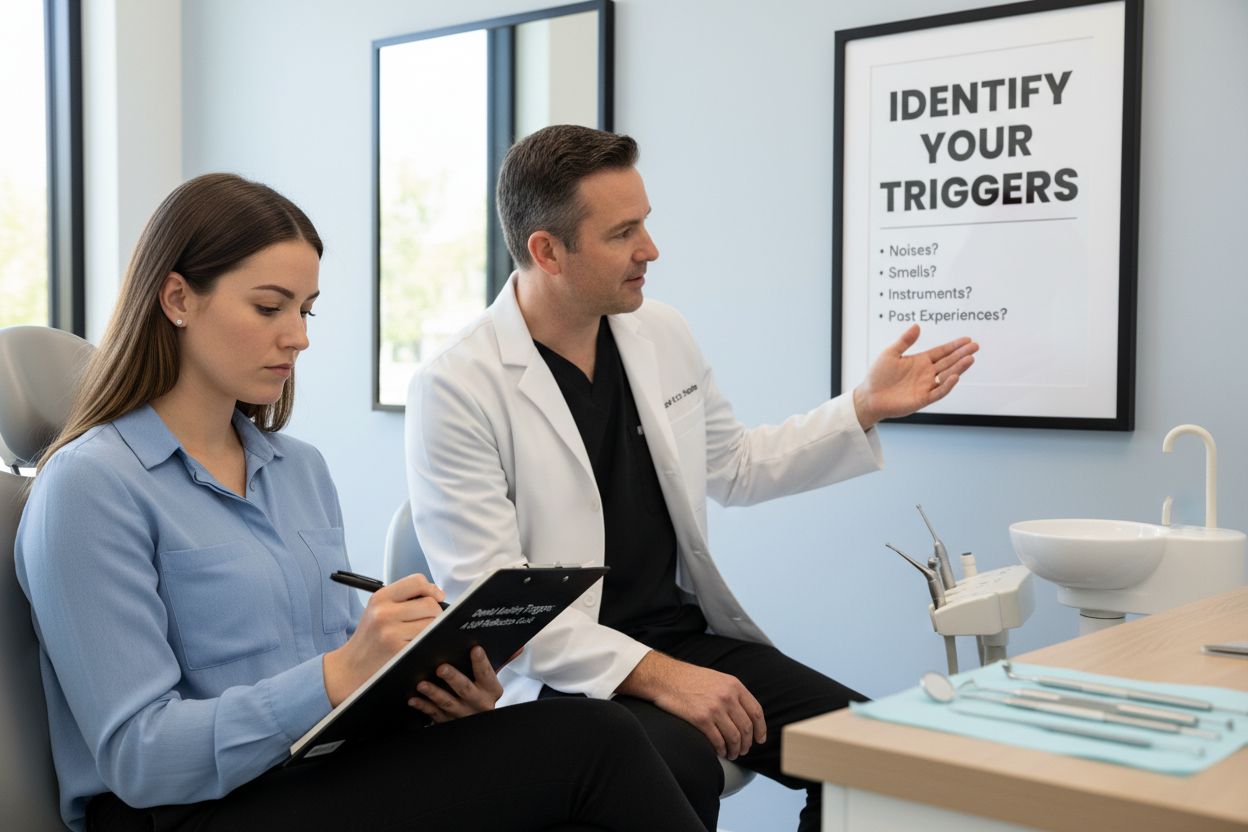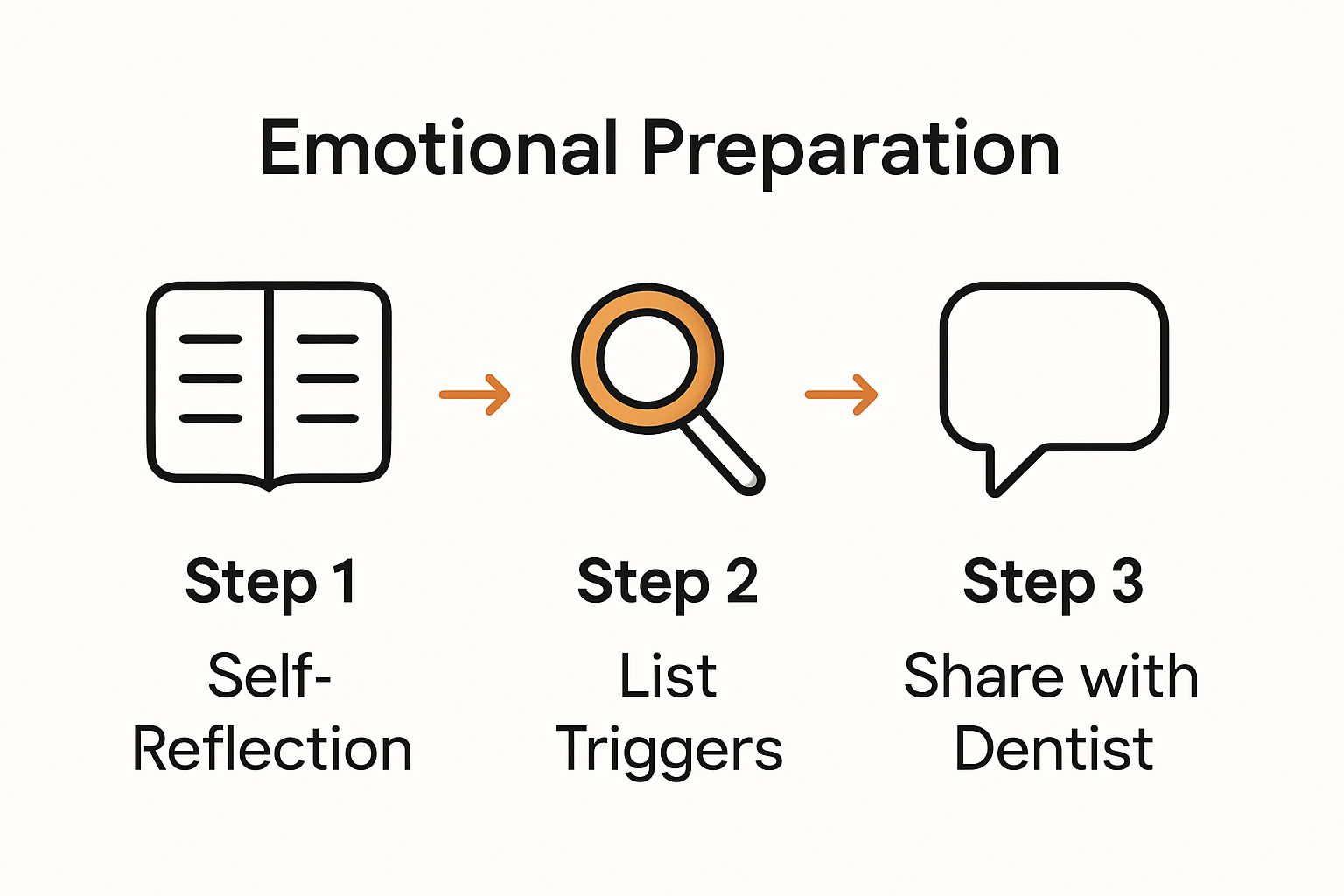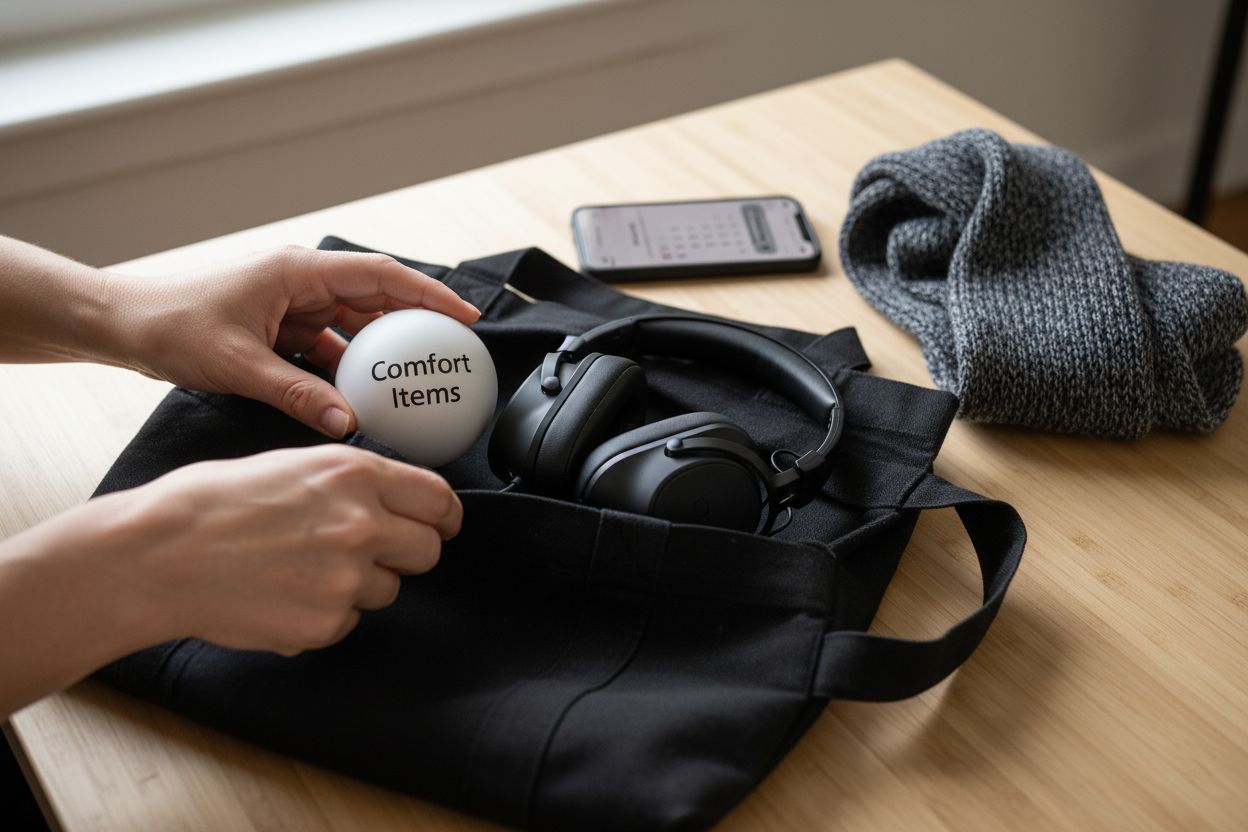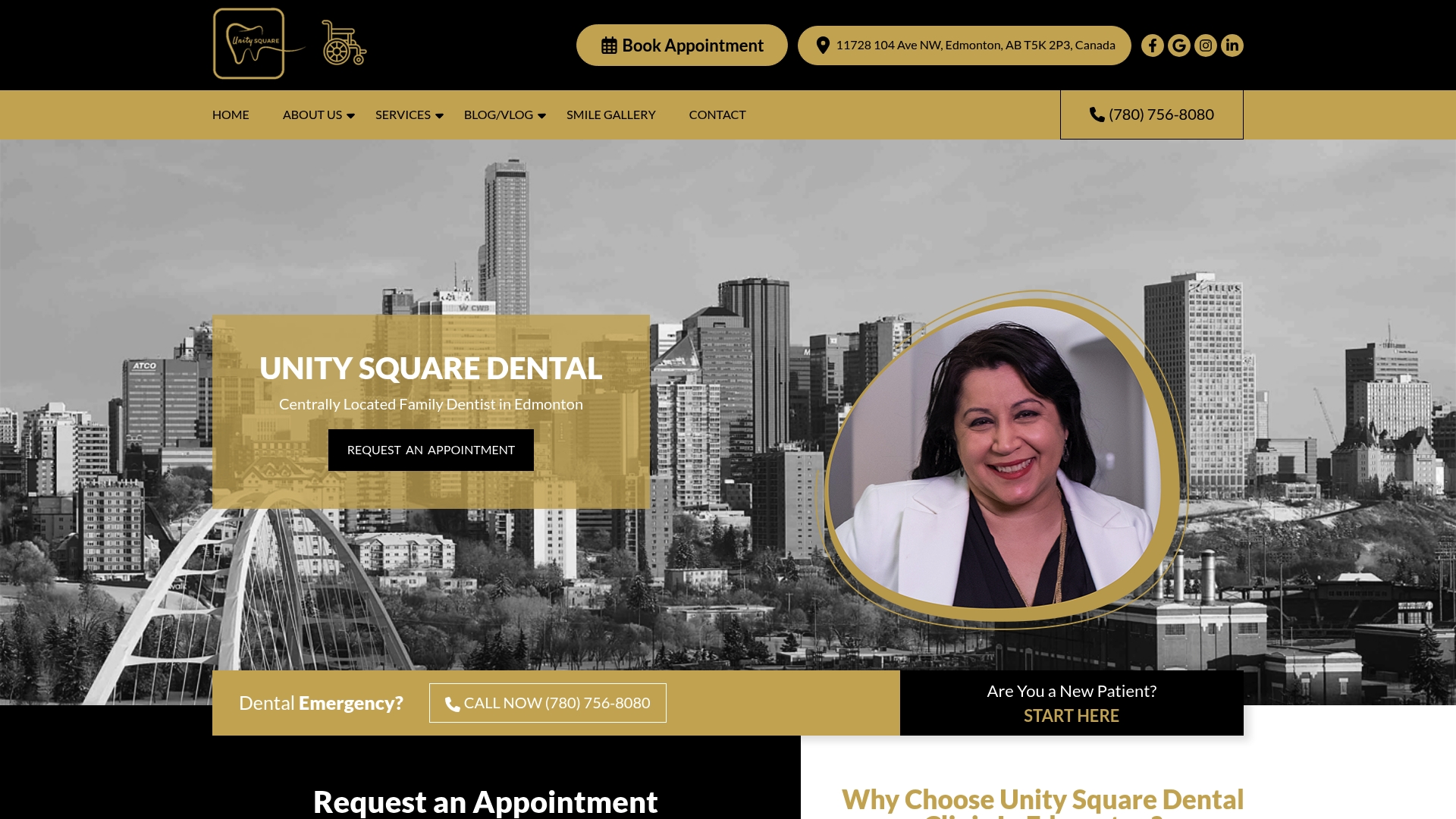
Dental anxiety affects nearly one in three adults, making routine checkups a major source of stress for millions. Most people imagine it is just about the fear of pain or the dentist’s chair. But the truth is, triggers can range from the faint click of dental tools to even just the scent of the clinic air. Unpacking these personal triggers can completely change how you experience every visit.
Table of Contents
- Step 1: Identify Your Triggers For Dental Anxiety
- Step 2: Research And Choose A Comfortable Dental Provider
- Step 3: Communicate Your Concerns With The Dentist
- Step 4: Utilize Relaxation Techniques Before Your Visit
- Step 5: Bring Comfort Items To Your Appointment
- Step 6: Follow Up For Continued Support And Care
Quick Summary
| Key Point | Explanation |
|---|---|
| 1. Identify your anxiety triggers | Understanding personal triggers is crucial in managing dental anxiety effectively. Reflect on past experiences to pinpoint specific concerns. |
| 2. Choose a supportive dental provider | Select a dentist experienced in managing patient anxiety to create a comfortable healthcare environment. Research and have consultations. |
| 3. Communicate openly with your dentist | Discuss your specific fears and triggers with your dental provider to develop tailored strategies that ensure comfort during procedures. |
| 4. Use relaxation techniques before visits | Implement deep breathing or visualization exercises prior to appointments to alleviate anxiety and improve your overall experience. |
| 5. Bring comfort items to appointments | Personal comfort items, like noise-canceling headphones or stress balls, can help anchor your emotions and reduce anxiety in the dental setting. |
Step 1: Identify Your Triggers for Dental Anxiety
Dental anxiety is a complex emotional response that varies for each individual, with specific triggers that can transform a routine dental visit into an overwhelming experience. Understanding and identifying these personal triggers is the critical first step in managing and ultimately reducing your dental anxiety.
Pinpointing your specific anxiety sources requires honest self reflection. Some individuals feel anxious about potential pain, while others experience deeper psychological responses connected to past traumatic dental experiences. Physical sensations like the sound of dental tools, the clinical environment, or fear of potential diagnoses can also provoke significant anxiety.
To effectively map your personal triggers, start by creating a detailed mental or written inventory of your specific concerns. Consider journaling about your previous dental experiences and documenting the precise moments or sensations that produced the most significant emotional response. Ask yourself targeted questions: What specific aspects of dental visits make you most uncomfortable? Is it the medical equipment, potential pain, loss of control, or something more nuanced?
Our guide on stress and dental health can provide additional insights into understanding the psychological components of dental anxiety. By systematically breaking down your emotional responses, you transform vague fears into concrete, manageable concerns that can be addressed through targeted strategies.

Recognize that identifying triggers is not about judgment but about developing self awareness. Each insight you gain becomes a strategic tool in managing your dental anxiety, bringing you closer to more comfortable and confident dental experiences. The goal is not to eliminate anxiety entirely but to understand it sufficiently to prevent it from controlling your healthcare decisions.
Step 2: Research and Choose a Comfortable Dental Provider
Selecting the right dental provider is a critical step in managing dental anxiety, transforming potential fear into a sense of safety and comfort. This process goes far beyond simply finding a qualified professional and involves discovering a healthcare partner who understands and respects your emotional needs.
First, leverage online resources and personal recommendations to compile a list of potential dental practices. Look for providers who explicitly advertise experience with patient anxiety, offering specialized support and compassionate care. Patient reviews can provide invaluable insights into a dental office’s approach to patient comfort. Pay close attention to comments describing staff sensitivity, communication style, and willingness to accommodate anxious patients.
Reach out directly to potential dental offices and ask specific questions about their approach to patient anxiety. Inquire about sedation options, communication protocols, and whether they offer preliminary consultations designed to help anxious patients feel more comfortable. Our guide on facing dental fear with relaxation techniques can provide additional strategies for discussing your concerns with potential providers.
Consider scheduling initial consultations with two or three providers to assess their environment and personal interactions. During these meetings, evaluate not just clinical competence but also emotional attentiveness. A compassionate dental team will listen to your concerns without dismissal, offer transparent explanations about procedures, and demonstrate a genuine commitment to making you feel secure.
Verify that your chosen provider offers practical accommodations for anxious patients. This might include options like noise-canceling headphones, the ability to pause procedures, clear communication about each step, or availability of mild sedation. The goal is finding a dental professional who views your anxiety not as an inconvenience but as a legitimate concern deserving personalized, empathetic care.
Step 3: Communicate Your Concerns with the Dentist
Effective communication is the cornerstone of managing dental anxiety, transforming a potentially intimidating experience into a collaborative healthcare journey. Your ability to openly and honestly discuss your fears with your dental provider can significantly reduce anxiety and create a supportive treatment environment.
Preparation is key when discussing your dental anxiety. Before your appointment, take time to organize your thoughts and specific concerns. Write down your triggers, past experiences, and particular aspects of dental procedures that generate the most stress. This documentation helps ensure you communicate comprehensively and don’t forget critical details during the actual conversation. Check out our guide on smart tips for staying calm during a dental visit for additional communication strategies.
Begin your conversation by establishing clear boundaries and expectations. Be direct and specific about your anxiety, explaining not just that you feel nervous, but precisely what generates those feelings. Some patients find it helpful to discuss past traumatic experiences or describe physical symptoms of anxiety, such as rapid heartbeat or sweating. A compassionate dental professional will listen without judgment and work collaboratively to develop strategies that make you feel secure.
Request a detailed explanation of each procedure before it begins, including potential sensations you might experience. Many anxious patients find that understanding the process demystifies the experience and reduces fear. Ask about potential pain management techniques, whether that involves local anesthesia, sedation options, or simple communication signals you can use to pause the procedure if you become overwhelmed.
Remember that vulnerability requires courage. By articulating your concerns, you’re not displaying weakness but demonstrating proactive healthcare management. A professional dental team will appreciate your honesty and work to create a personalized approach that respects your emotional and physical comfort. Your goal is to establish a partnership where you feel heard, understood, and supported throughout your dental treatment.
Step 4: Utilize Relaxation Techniques Before Your Visit
Relaxation techniques are powerful tools for managing dental anxiety, transforming potential stress into a calm and controlled experience. These strategies work by interrupting anxiety cycles, redirecting mental focus, and activating your body’s natural relaxation response.
Deep breathing exercises serve as an immediate and accessible method for reducing tension. Practice diaphragmatic breathing by inhaling slowly through your nose for four counts, holding briefly, then exhaling gradually through your mouth. This technique helps regulate your nervous system, reducing heart rate and promoting physical calmness. According to research from the Very Well Mind, guided imagery combined with controlled breathing can significantly lower anticipatory anxiety.
Begin incorporating relaxation techniques several days before your dental appointment. Create a personalized pre-appointment ritual that signals safety to your nervous system. This might include listening to calming music, practicing meditation, or engaging in gentle stretching. **Visualization can be particularly powerful for anxious individuals.
** Spend time mentally rehearsing a positive dental experience, imagining yourself feeling relaxed and comfortable throughout the procedure.
Consider creating a sensory toolkit to support your relaxation efforts. This could include noise-canceling headphones playing soothing music, stress relief objects like smooth stones or fidget tools, and comfortable clothing that helps you feel secure. Some patients find aromatherapy with calming scents like lavender helpful in reducing anticipatory anxiety.
Ultimately, the goal is developing a personalized approach that feels authentic and supportive to your unique emotional landscape. Experiment with different techniques to discover what resonates most strongly with your individual experience. By investing time in preparation and self-care, you transform dental visits from potentially overwhelming experiences into manageable, controlled interactions where you maintain a sense of personal agency and calm.
To help you prepare for your next dental visit, here is a comparison of commonly recommended relaxation techniques, their benefits, and when to use them.
| Relaxation Technique | Benefit | When to Use |
|---|---|---|
| Deep Breathing | Reduces heart rate and tension | Before and during appointment |
| Guided Imagery/Visualization | Lowers anxiety by creating calming focus | Before and during appointment |
| Listening to Calming Music | Distracts from stressful sounds | Before and during appointment |
| Gentle Stretching | Releases physical stress | Prior to leaving for appointment |
| Aromatherapy (e.g., lavender) | Promotes relaxation and calm | At home before appointment |
| Meditation | Enhances overall relaxation and awareness | Several days before appointment |
| Use of Sensory Toolkit | Provides comfort and emotional stability | During appointment |
Step 5: Bring Comfort Items to Your Appointment
Bringing personal comfort items to your dental appointment is a strategic approach to managing anxiety, creating a sense of security and control in an environment that might otherwise feel intimidating. These carefully selected items serve as emotional anchors, helping you maintain composure and feel more grounded during your procedure.
Noise-canceling headphones are an excellent tool for creating a personalized auditory environment. By blocking out clinical sounds that might trigger anxiety, you can listen to calming music, guided meditations, or podcasts that help redirect your mental focus. Learn more about our dental clinic amenities that can complement your personal comfort strategies. Consider creating a playlist specifically designed to soothe your nerves, with music or audio content that has consistently helped you feel relaxed in other stressful situations.
Tactile comfort items can provide significant emotional support. A small, soft object like a stress ball, smooth stone, or fidget tool can give your hands something to focus on, helping disperse nervous energy. Some patients find weighted blankets or soft scarves helpful, as the gentle pressure can create a sense of security. If you have a particular item that brings you comfort personal significance – perhaps a small photograph or a meaningful trinket – consider bringing it to your appointment.
Communication is key when introducing comfort items. Discuss your planned items with your dental team beforehand to ensure they are compatible with the clinical environment. Most professional dental providers are understanding and will work to accommodate your needs, recognizing that patient comfort directly impacts treatment effectiveness.
Here is a checklist of comfort items to bring to your dental appointment, along with their purpose and considerations for use.
| Comfort Item | Purpose | Considerations |
|---|---|---|
| Noise-canceling Headphones | Block clinic sounds, provide music | Ensure compatibility with procedures |
| Stress Ball/Fidget Object | Disperse nervous energy | Keep small for easy handling |
| Weighted Blanket/Scarf | Provide gentle, calming pressure | Check with staff for acceptable items |
| Personal Photograph/Trinket | Offer emotional grounding | Choose something compact and meaningful |
| Aromatherapy Item | Promote relaxation with scent | Use only if permitted by clinic |
| Comfortable Clothing | Enhance feeling of security | Wear clothes that do not interfere with care |

Step 6: Follow Up for Continued Support and Care
The journey of managing dental anxiety extends far beyond a single appointment, requiring ongoing commitment, reflection, and proactive communication. This final step focuses on transforming your initial experience into a sustainable approach for long term dental health and emotional well being.
Schedule a post appointment debrief with yourself to honestly assess your experience. Take time to journal about what strategies worked effectively, which moments felt challenging, and how you might refine your approach for future dental visits. This self reflection helps build emotional resilience and provides valuable insights into your unique anxiety management process. Our guide on essential questions to ask your dentist can help you develop a more comprehensive understanding of your dental care journey.
Reach out to your dental provider for a follow up conversation about your experience. Many dental professionals appreciate hearing patient feedback, especially from individuals working to manage anxiety. Discuss the techniques that helped you feel more comfortable, and explore additional support options for future appointments. This might include developing a customized anxiety management plan, exploring progressive sedation techniques, or scheduling longer appointments with more breaks.
Recognize that managing dental anxiety is an ongoing process of personal growth and self compassion. Each dental visit becomes an opportunity to build confidence, challenge previous negative experiences, and develop more effective coping mechanisms. Consider connecting with support groups or seeking additional professional counseling if dental anxiety continues to significantly impact your healthcare decisions. Your commitment to addressing these feelings represents a profound act of self care, demonstrating courage and dedication to your overall health and well being.
Ready to Turn Dental Fear into Confidence?
Struggling with dental anxiety can feel isolating, especially when triggers like unfamiliar tools, past traumas, or the fear of pain overwhelm you. Our article showed that understanding your triggers and building self-informed strategies is the first step. Now, imagine experiencing care tailored to your personal comfort in a supportive environment, where your concerns are respected and your anxieties are met with proven techniques like guided relaxation and sedation dentistry.

Unity Square Dental is committed to transforming your dental visits into positive experiences. We use advanced technology, offer patient-centered amenities, and provide a wide range of supportive services for anxious patients. From clear explanations and flexible scheduling to options like sedation and direct billing, our team is here for you. Start your path to stress-free dental care by visiting Unity Square Dental. You can also explore our gallery of amenities to see how we make comfort a priority. The sooner you reach out, the sooner you can experience dental visits without anxiety holding you back. Book an appointment today and take control of your dental health with confidence.
Frequently Asked Questions
How can I identify my triggers for dental anxiety?
Understanding your triggers involves self-reflection and journaling about past dental experiences. Take note of what aspects of dental visits make you uncomfortable, such as pain, sounds, or specific procedures.
What should I look for when choosing a dental provider to help with anxiety?
When selecting a dental provider, consider their experience with patient anxiety, read patient reviews, and inquire about their communication style. Look for offices that offer accommodations like sedation options or preliminary consultations.
What relaxation techniques can I use before my dental appointment?
Techniques such as deep breathing exercises, guided imagery, and listening to calming music can help reduce anxiety. Creating a pre-appointment ritual involving these practices can signal safety to your nervous system.
How can I communicate my anxiety to my dentist effectively?
Prepare by writing down your specific concerns and triggers. Be open and honest about your feelings and request detailed explanations about procedures. Establishing clear boundaries can help create a supportive treatment environment.
Recommended
- 9 Smart Tips for Staying Calm During a Dental Visit – Unity Square Dental
- Dental Care for Families in Edmonton: Your 2025 Guide – Unity Square Dental
- Overcome Dental Anxiety with Guided Relaxation & Imagery
- Overcoming Fear of Dentists: Your Guide to Stress-Free Visits – Unity Square Dental
- anxiety management – ParakeetAI
- Anleitung zur Hypnose gegen Stress: So finden Sie Ruhe und Entspannung

